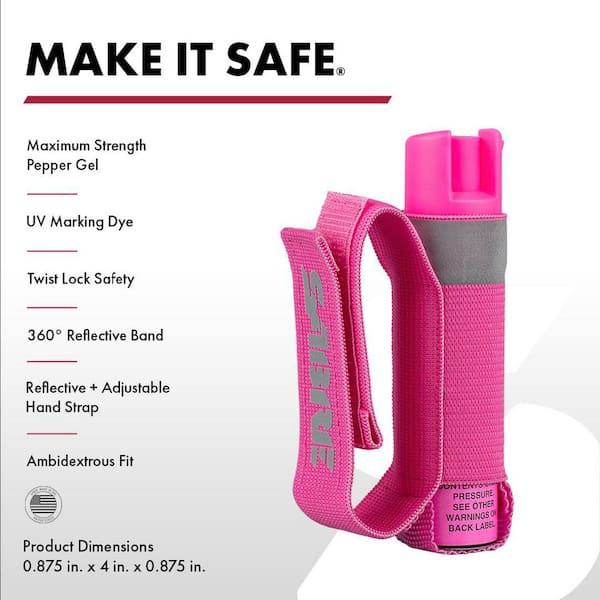Table of Contents
- Understanding the Risks of Using Pepper Spray in Enclosed Spaces
- Health Implications of Indoor Pepper Spray Exposure
- Effective Safety Measures for Indoor Pepper Spray Use
- Expert Recommendations for Responsible Pepper Spray Handling Indoors
- To Conclude
Understanding the Risks of Using Pepper Spray in Enclosed Spaces
Using pepper spray in confined areas can significantly amplify its effects, often leading to unintended and severe consequences. Due to the limited ventilation, the irritant particles linger longer in the air, intensifying the burning sensation not only for the target but also for bystanders and the user themselves. This can cause widespread discomfort and even respiratory issues, especially for individuals with asthma or other pre-existing conditions. Furthermore, the inability to quickly escape the affected area increases the risk of prolonged exposure, which can lead to complications such as coughing, eye irritation, and temporary vision impairment.
Before deciding to deploy pepper spray indoors, consider these crucial factors:
- Ventilation: Ensure there is adequate airflow to help disperse the irritant quickly.
- Proximity: Be aware of the distance between you, the assailant, and others to minimize collateral exposure.
- Health Risks: Evaluate any known respiratory conditions that could be aggravated by the spray’s effects.
- Escape Routes: Confirm that you and others have clear, unobstructed paths to exit the space safely after deployment.
Health Implications of Indoor Pepper Spray Exposure
Indoor exposure to pepper spray presents several health risks that are often more intense than outdoor use due to confined spaces and limited ventilation. The active compound, capsaicin, can cause immediate respiratory distress, including coughing, wheezing, and difficulty breathing, which can escalate into severe bronchospasm, particularly for individuals with pre-existing conditions like asthma or chronic obstructive pulmonary disease (COPD). Additionally, the spray irritates mucous membranes, resulting in burning sensations in the eyes, nose, and throat. Prolonged exposure may lead to persistent inflammation and, in extreme cases, secondary infections if the eyes or respiratory tract are compromised.
Understanding these risks is crucial before deciding to deploy pepper spray indoors. Key considerations include:
- Ventilation: Poor air circulation can trap airborne particulates, increasing exposure duration and symptom severity.
- Vulnerable populations: Children, elderly people, and those with respiratory ailments face heightened health risks.
- Post-exposure environment: Residual particles settling on surfaces can continue to cause irritation long after use.
Taking these factors into account can help mitigate harm, but users should always weigh the necessity of indoor deployment against potential health consequences to prevent unintended trauma.
Effective Safety Measures for Indoor Pepper Spray Use
When deploying pepper spray inside a confined space, taking deliberate precautions is crucial to minimize health risks and unintended consequences. Ensure proper ventilation immediately after use by opening windows and doors to allow fresh air to circulate, helping dissipate the irritants quickly. It’s also important to avoid spray discharge near sensitive individuals, pets, or anyone with respiratory issues to prevent severe reactions. Keeping a safe distance from the target and using short bursts can reduce excessive spread of the spray particles within the room. Remember, having a clear escape route is essential to avoid prolonged exposure after deployment.
Additionally, having emergency supplies such as water, saline eye wash, and face masks nearby can drastically help in managing the aftermath efficiently. Educate all household members about how to react if exposed-such as flushing eyes with cool water and moving to fresh air immediately. Proper storage of pepper spray, away from children and in an accessible yet safe spot, is equally important. By following these guidelines, you can maintain a responsible approach to pepper spray use indoors while prioritizing the safety of everyone present.
- Ventilate the area promptly after use to clear the air.
- Avoid direct spraying on non-threat individuals or pets.
- Use short, controlled bursts to limit spread.
- Keep emergency eye wash and water accessible.
- Inform all household members about safety protocols and post-exposure actions.
Expert Recommendations for Responsible Pepper Spray Handling Indoors
Experts emphasize that using pepper spray indoors requires heightened caution, as confined spaces intensify its effects and can inadvertently harm bystanders. To mitigate risks, ensure the area is as well-ventilated as possible before deployment. In addition, always position yourself with an accessible escape route to avoid prolonged exposure to the irritant. Prior to any use, verify that no vulnerable individuals such as children, elderly, or those with respiratory conditions are nearby, as pepper spray can exacerbate health issues in these populations.
Implement these essential best practices to responsibly handle pepper spray indoors:
- Test your device regularly to confirm it functions correctly without accidental discharge.
- Store pepper spray securely out of reach of unauthorized individuals, preferably in a locked container.
- Inform household members about the purpose and risks associated with pepper spray.
- Practice controlled deployment techniques that focus on targeting only the intended threat to prevent collateral exposure.
- Have neutralizing agents or first-aid supplies ready, such as saline eye wash, to assist anyone affected unnecessarily.
To Conclude
In conclusion, while pepper spray can be an effective means of self-defense, using it indoors comes with distinct risks and considerations. Experts advise that factors such as ventilation, the presence of bystanders, and the potential for accidental exposure should heavily influence your decision to deploy pepper spray inside. Ultimately, understanding both the benefits and limitations of pepper spray in enclosed spaces can help you make safer, more informed choices when it comes to protecting yourself and others. Stay aware, stay prepared, and prioritize safety above all.Check Our Other Blogs
- StunGun – Your Trusted Source for Stun Guns, Laws, and Self-Defense Tips
- PepperSprayLaws – Your Trusted Resource for Pepper Spray Information
- StunGunLaws – Your Trusted Guide to Stun Gun Legality and Safety




